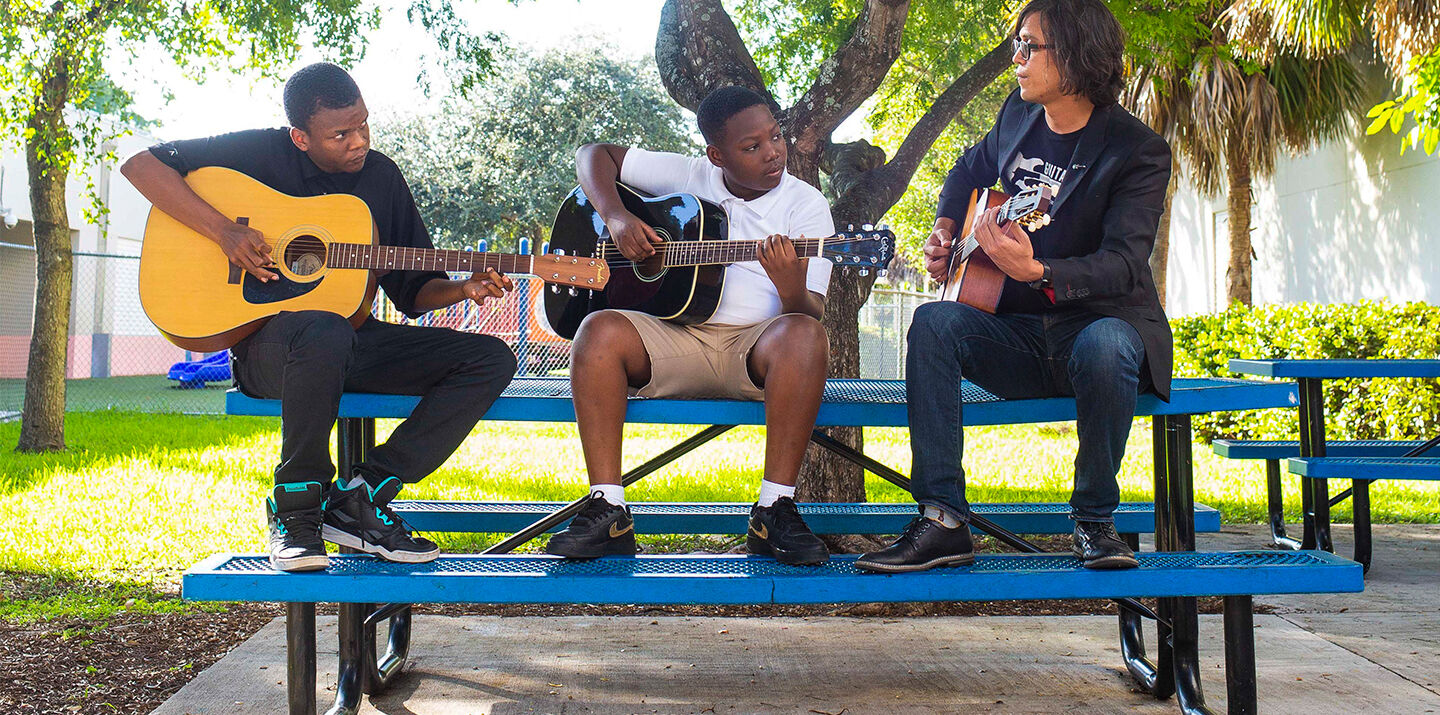
Miami Turns Up the Sound
A childhood without music? No one wants that. But in a city overflowing with creative talent, it’s harder than it looks to bring music education to every student.
It’s hard to think of an American city that feels more blazingly alive with creative expression than Miami. An incomplete list of the arts and culture that Miami produces would include every form of live music, music recording, dance, mural art, gallery and museum art, fashion, film production, telenovela production.
Miami is also chock-full of musicians who are drawn to the abundance of studio and live performance venues and the rich sampling of arts produced by Miami’s immigrant mix. Some, like former teachers and music enthusiasts Trevor Ditzler (Miami-Dade ’11) and Jono De Leon (Miami-Dade ’07), have helped to launch or expand organizations to provide music education. They want to do for today’s students what music did for them when they were growing up: help them survive the rigors and traumas of childhood to grow into creative, life-affirming adults.
Right now, there are more than 65 nonprofit organizations in Miami-Dade that are bringing various forms of music education to kids. Most are programs that complement whatever music education students get through their K-12 schools’ curricula.
Rebecca Fishman Lipsey (N.Y. ’04) knows many of these music entrepreneurs well. She runs a Miami social accelerator called Radical Partners. And every year when Radical Partners opens a new cohort for entrepreneurs ready to scale their ventures, she sees many music entrepreneurs apply.
From reading their applications year after year, Lipsey has seen that they share common skills and passion, yet they’re rivals. Each feels strained for resources and anxious that some other group will win the $10,000 grant all are going after.
Whether their organization promotes violin-playing, children’s choruses, or electronic music production, Lipsey saw each struggling in isolation to work with principals to get their programming into schools, to decipher the regulations around after-school programs. Each has been out there begging or trying to buy instruments, sell free lessons to parents, and pay rent.
Meanwhile philanthropists felt the strain of navigating a high volume of small requests from all the organizations doing parallel work. Local philanthropist Daniel Lewis began scheming with Lipsey about how much more effective everyone could be if they could help music entrepreneurs work together to leverage their assets to reach more kids.
In 2019, 17 music and education leaders joined forces to give that a try. They applied and were accepted into what Lewis and Lipsey called the Music Access Fellowship. This was a year-long experiment to test whether competitors could become collaborators and start on the path to achieving a transformative goal for the region’s children. Could a collective of sound engineers, guitar players and old-line cultural stalwarts begin to lay the foundation for every student in Miami-Dade County to get access, every year, to music education?
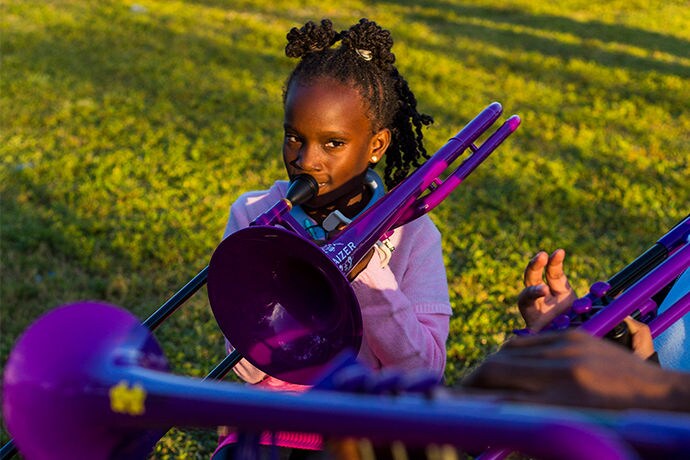
Why It Matters
Decades of research have produced evidence that music—learning to read it or play it or sing it—activates every part of a child’s brain. It helps with memory recall. It strengthens kids’ literacy skills, their hand-eye coordination, and their social and emotional capabilities. It just makes them happy, inspiring mindsets and behaviors that lead kids to engage more positively in and out of school.
Students who learn music have been found to graduate at higher rates and score higher on college admission exams. And new findings from a 10-year study that controlled for students’ home exposure to the arts found evidence that in-school music and art classes might have even more profound benefits for students whose families earn lower incomes.
Art and music are often the first classes to vanish when schools are under budget or staffing or time pressures. But there’s evidence that trend may be reversing. The Hechinger Report recently reported that more schools across the country are offering music today, and employing full-time music teachers, than did so 20 years ago. That’s according to results from two major surveys administered by the U.S. Department of Education. Those findings apply equally to districts that serve mostly poorer communities.
New research from Rice University in Houston, involving 10,000 third through eighth graders, underscores the value of enriching schools’ offerings by bringing in artists and musicians from the community. Researchers surveyed the results among students at 42 Houston schools who were randomly assigned to spend more time learning art and music through school-and-community partnerships with teaching artists and local arts organizations.
The researchers found that increasing arts education led to fewer disciplinary infractions among the participating students, higher writing achievement, and increased empathy and compassion. Among elementary-aged kids, they saw upticks in school engagement and college aspirations.
Then there’s the evidence that parents want and expect schools to provide music education. Samantha Fraser is a single mother of 10-year-old twins, Thalia and Tyler, and a passionate advocate of the UP! Music instrumental after-school program at Miami’s Jesse J. McCrary, Jr. Elementary School, which sits on the border between Little Haiti and Liberty City.
Fifth graders Thalia and Tyler both play purple plastic trombones in the after-school band led by a certified music teacher and saxophone aficionado, Darryl Clark. It’s rare for elementary schools to have instrumental bands. But UP! Music’s founder, Trevor Ditzler, believes students are owed the chance to start learning an instrument early, to continue their instruction in the same instrument when they reach their feeder-pattern middle school, and to be strong players by the time they get to high school—where they should have access to joining a marching band.
At McCrary school, Samantha Fraser first enrolled her twins in after-school classes in percussion and simple keyboard instruments. Then Tyler and Thalia joined the after-school band because their mother saw them looking exhausted and stressed by their intensive academic days layered with frequent tests. She wants them to learn reading and math, and she also wants to see them smile when she comes to visit school.
Fraser has a second agenda. “Not every student is going to get an academic scholarship to college,” she says. “My children need to get scholarships. So if they’re going to learn an instrument, they need to learn it well. If they’re going to play a sport, they’re going to play it well. I’m going for the trifecta: a scholarship in music, sports, or academics.”
The most compelling evidence might come from how educators see students react to opportunities not just to learn music but to choose the style of music they learn. At Linda Lentin K-8 Center in North Miami, Guitars Over Guns (a member organization of the Music Access Fellowship) runs an after-school program where working musicians teach and mentor middle school students. Several students have started with vocal or instrumental music only to switch to the other.
Students are encouraged to make choices. What songs should we learn? Do you feel like playing today in the band room, or out in the hall, or outside? As a December school performance approached, the vocal ensemble coach Shawnnette Longley (who records “psychedelic alternative soul” music under the name RIMIDI) led students in rehearsing their harmonies. Then she threw it to them to invent some moves. “Now how are you going to make it exciting for you,” she asked the students, “so you can make the performance exciting for your audience?”
Some students essentially live to play. Twelve-year-old Wilgina Dastinot, a seventh grader in the Guitars Over Guns program, remembers that she wanted so badly to learn to play when she was younger that she wrapped rubber bands around a book and pretended to strum guitar. Now she’s learning from a professional jazz musician, Bryce Bottomly, the guitar mentor at her school. She peered intently at her fingers on the fret board as she worked on the chords to “Old Town Road” on a Wednesday afternoon in December. “What I really enjoy,” she said. “is that we have this opportunity to learn to play the guitar for free.”
Her classmate, 14-year-old Jonathan Hence, knows exactly whom he aspires to be when he grows up: Prince. “He plays every instrument, he writes every song, he produces every sound,” Jonathan said. “I could do that.”
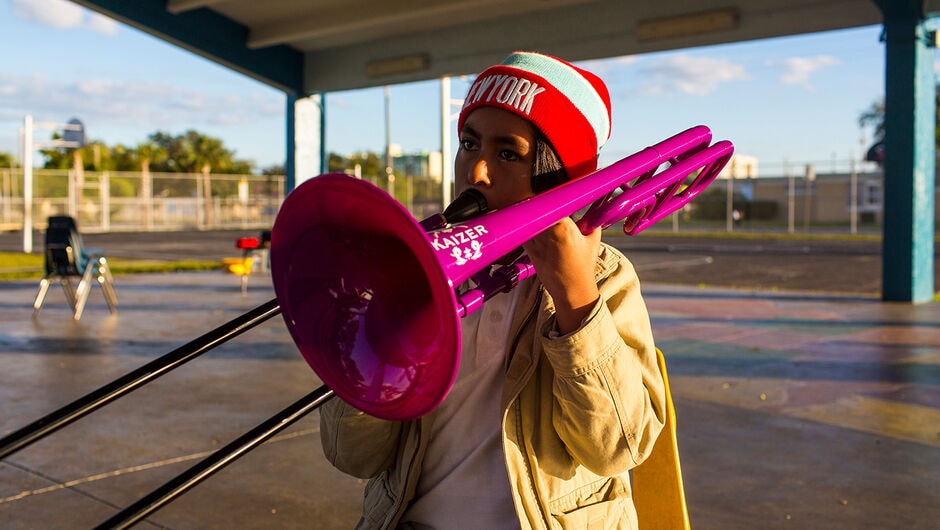
What Did They Learn?
Trevor Ditzler was just two years into launching UP! Music (under the umbrella of the expanded-learning-time nonprofit Achieve Miami) when he was accepted into the Music Access Fellowship. To him, the effort to get leaders thinking like a team just made sense. “There’s been a huge lack of collaboration and a huge lack of working together for a common outcome for kids, as opposed to working for the preservation of our own organizations,” he says. “Every one of us has a common interest in solving the problem of music access. I think building a community of like-minded people, and helping them focus on the larger goal, could have rippling positive repercussions throughout the community.”
“I was dying to be in this fellowship,” says Sammy Gonzalez, a bassist and guitarist who runs one of the bigger music education nonprofits in Miami, Young Musicians Unite, and who also co-founded a production company and a private music school
Young Musicians Unite has a success record and plenty of entrée into schools. But Gonzalez felt musicians had been thinking too small. Their individual asks left holes in student access across the system. “If we can partner together and make bigger asks, we can have a bigger impact on students,” Gonzalez says. “If we get enough people together and we’re sitting with board members and superintendents and politicians, we can get something done.
“We’re all facing the same obstacles,” he adds. “We all use musicians as teachers. Maybe we could train them all together instead of each of us training them separately and wasting a lot of money.”
With $1 million in underwriting from Daniel Lewis, the members of the Music Access Fellowship spent the last year together getting to know and trust each other. They explored which niche each filled. Fellows formed partnerships to pilot some new joint programming. The whole group met monthly to track how partnerships were going. They visited and observed each other’s programs and began to share advice and resources.
Lipsey at Radical Partners started to feel the fellowship was building toward something when two leaders, who had been explicit competitors, tag-teamed to offer a principal a combination of their in-school and after-school music programs.
Lipsey also could see fellows making organic connections. Take Sandy Dorsainvil, a fellow who founded the Rara Institute of Music. Rara is a form of Afro-Caribbean festival music that’s played on traditional African handmade instruments (in Miami by Haitian musicians). Originally composed without notation, Rara needs to be passed from musician to musician. Dorsainvil had seen kids trying to jump into Rara performances at festivals, and at first she was most excited to get fellowship funding to teach students to write and record Rara at Miami’s Little Haiti Cultural Complex and the SEED School of Miami.
But then Dorsainvil and Sammy Gonzalez became pals and went to work on an idea. Dorsainvil thinks it’s a waste for her organization to build the expertise to approach schools to hire her Rara teaching musicians. What if instead she could team up with Gonzalez and Rara could become a format that students could opt into learning at some of the 20 schools that host Young Musicians Unite?
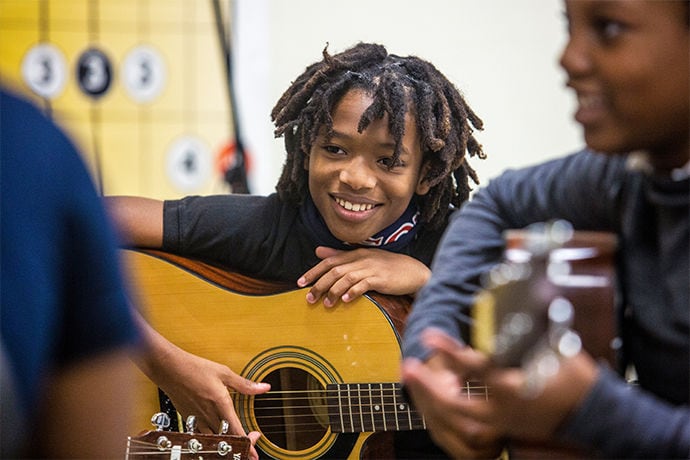
Will It Grow?
The Music Access Fellowship lasted a year and ended in December. Not everyone became best friends. Not all the one-on-one partnerships progressed beyond the dating stage. “This fellowship forced us to be very honest with each other,” Gonzalez says. But the 17 fellows and the Radical Partners team learned. They traveled together to retreats at places like Interlochen Center for the Arts in northwest Michigan where they immersed themselves with experts in systems-building. They had many conversations about how to make progress on building an ecosystem, and next steps.
They built an asset map (soon to become an interactive online map) of the 65 nonprofits active in music education across Miami-Dade County. They held an event where all 65 organizations were invited to come together for a kind of speed-dating day. Attendees were still brainstorming, bumping elbows and swapping cards when the organizers were turning out the lights.
They’re considering for the upcoming school year choosing one neighborhood where they can collaborate to give every student in that feeder pattern access to music education.
“We don’t know the answers to all the questions yet,” says Ashley Extra, a Music Access Fellow who also leads programming as a senior managing director at Teach For America Miami-Dade. “But something beautiful happened when people started to move from a scarcity to an abundance mindset. We could see all the assets we have in this group of fellows and in all the different communities we serve. We got to the point where we were thinking strategically not just about access, but about setting a bar for quality.”
Lipsey believes the project will likely enter a new phase where the fellows form alliances to move joint projects forward. She’s looking to see whether other public, private, or community institutions opt to continue any of the initial music education funding that came through the fellowship.
She’s also checking for who among the 65 music education nonprofits in Miami-Dade is ready to go together. Lipsey says, “There comes a time when you reach a tipping point where enough people view collective action as a way forward. The outliers and the skeptics shift, and this kind of collaboration is just what the ecosystem does.”
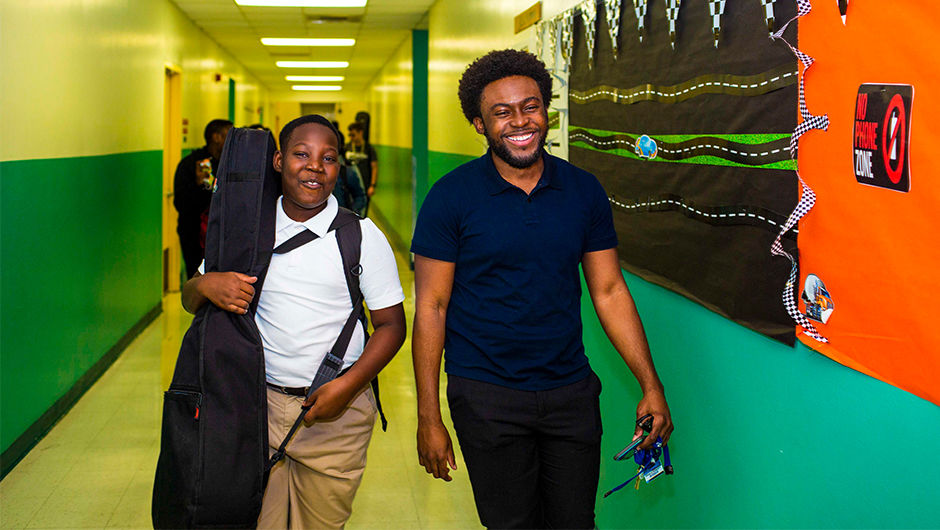
Why a Non-Music Teacher Said Yes to Music
Francis Morency has said yes to every opportunity that’s come his way since he started teaching middle school students as a member of the 2017 Miami-Dade corps.
Having grown up in Miami, bilingual in English and Haitian Creole, Morency left to attend Syracuse University on a Posse Foundation scholarship. He worked every summer coaching or teaching kids through programs like Breakthrough Collaborative and Outward Bound. As a young student, he’d had some rough moments, and he loved showing local kids: Hey, I’m doing it.
After he joined the corps he was assigned to teach history, civics, and law at Linda Lentin K-8 Center in North Miami, and that’s when he started saying yes to every opportunity. Grade level chair in his subject. Planner of student history trips to Philadelphia. Member of the committee to allocate school funding. Six full classes, no planning period. And he was constantly changing up his curriculum, especially after he realized students were using his materials to help their parents become citizens.
But something really bothered Morency during his first year of teaching. His classroom was next to the band room. He never heard any music coming from there.
Last summer, the non-profit organization Guitars Over Guns teamed with Teach For America-Miami Dade (both were involved in the Music Access Fellowship), to bring the after-school music program to some new school sites. One of those was Linda Lentin. Morency’s principal approached him to ask if he’d take on one more task: being the teacher-leader and site director of this new after-school program that would offer vocal and guitar classes to students.
Morency was busy, at the time, doing all the prep work to shift his civics classes to focus on law and student law competitions. He was studying for his LSATs. He finally turned down the opportunity, telling his principal, “I’m not a musician. I can’t do that.”
But then he reconsidered, thinking back to what had happened when, at the end of his institute training in 2017, he was asked to speak at the Teach For America Miami-Dade corps induction event.
Morency was standing backstage when he heard a voice come from another invited speaker: “Francis! What are you doing here?”
It was Jono De Leon. A member of the 2007 Miami-Dade corps, De Leon taught for eight years at his placement school while he was building toward the music education nonprofit that he and his partner, president and CEO Chad Bernstein, eventually spun off to become Guitars Over Guns. In his first year of teaching, De Leon had had a student named Francis Morency—the same Francis who, 12 years later, had just been asked by his principal to lead the Guitars Over Guns after-school program.
As the start of this school year approached, De Leon reached out to his former student and convinced him, as Morency says, “how important music programs are for students.” That was the push Morency needed to join the three-way partnership between his school, Guitars Over Guns, and Teach For America-Miami Dade.
“There’s something just cosmically wonderful about finding Francis again,” De Leon said recently on a day he came to visit Morency at his school, and to show him an essay that Morency had written as a student of De Leon’s when he was age 12.
“If that’s not the cosmos telling us we’re doing something right, I don’t know what is.”
Sign up to receive articles like this in your inbox!
Thanks for signing up!
Content is loading...


